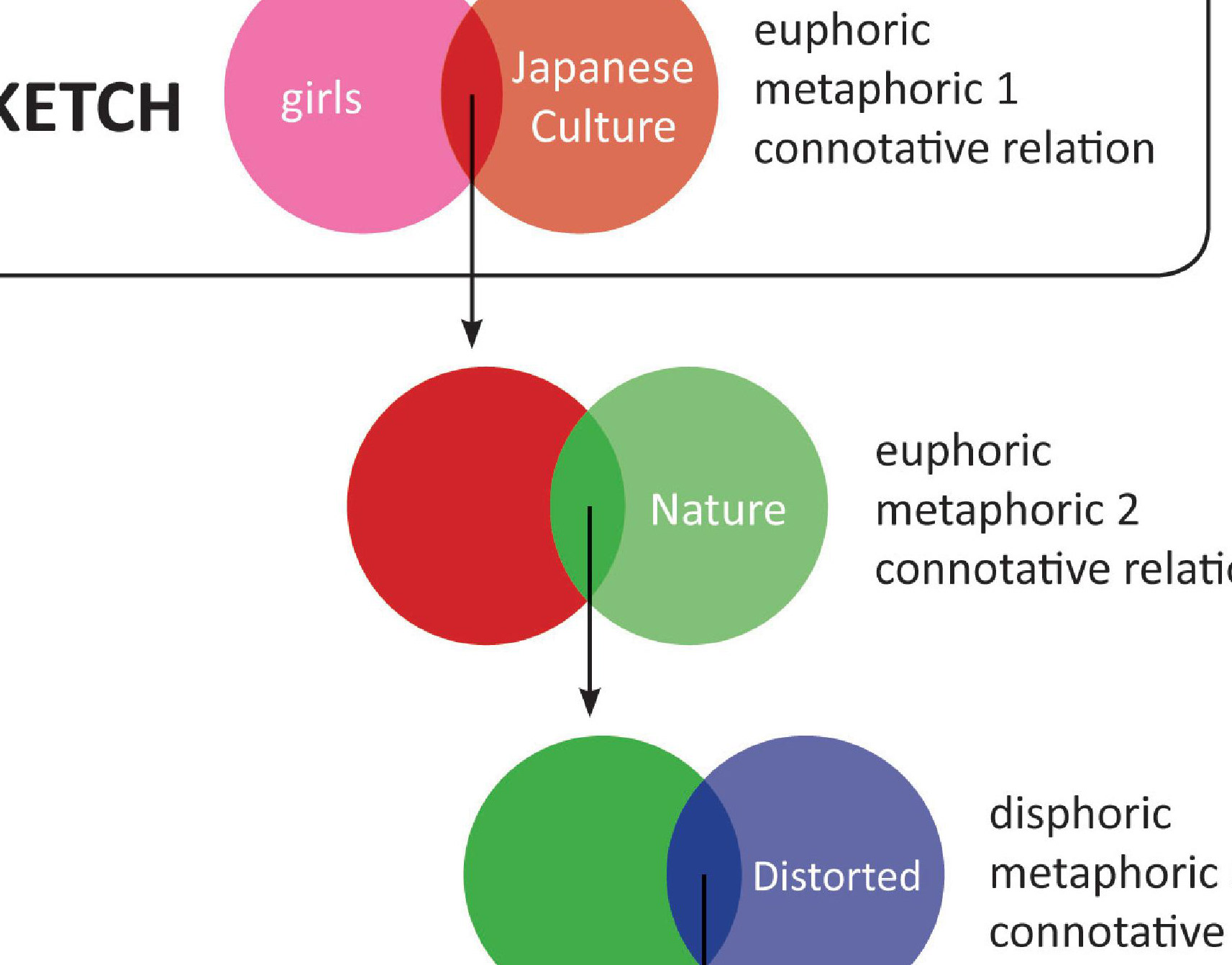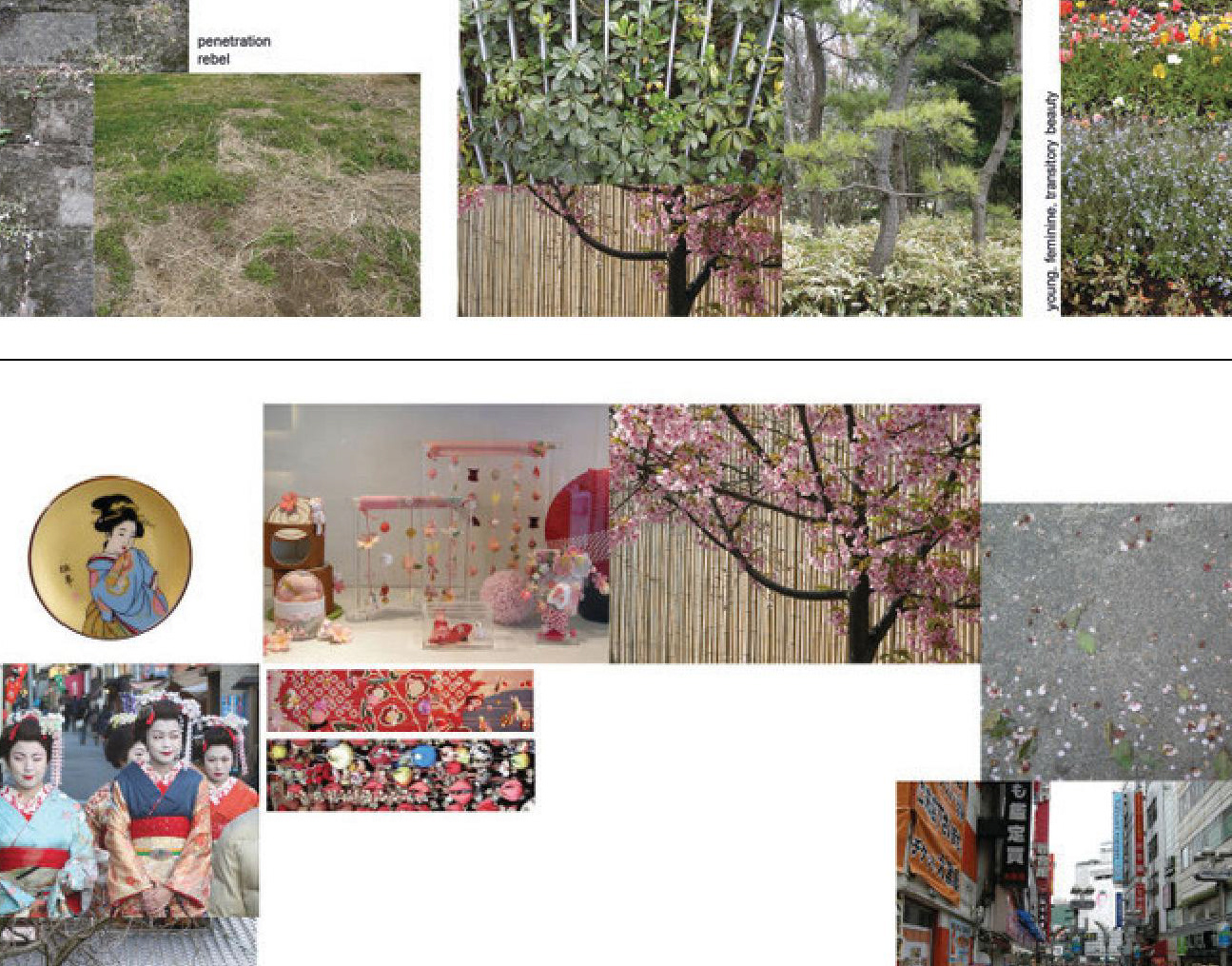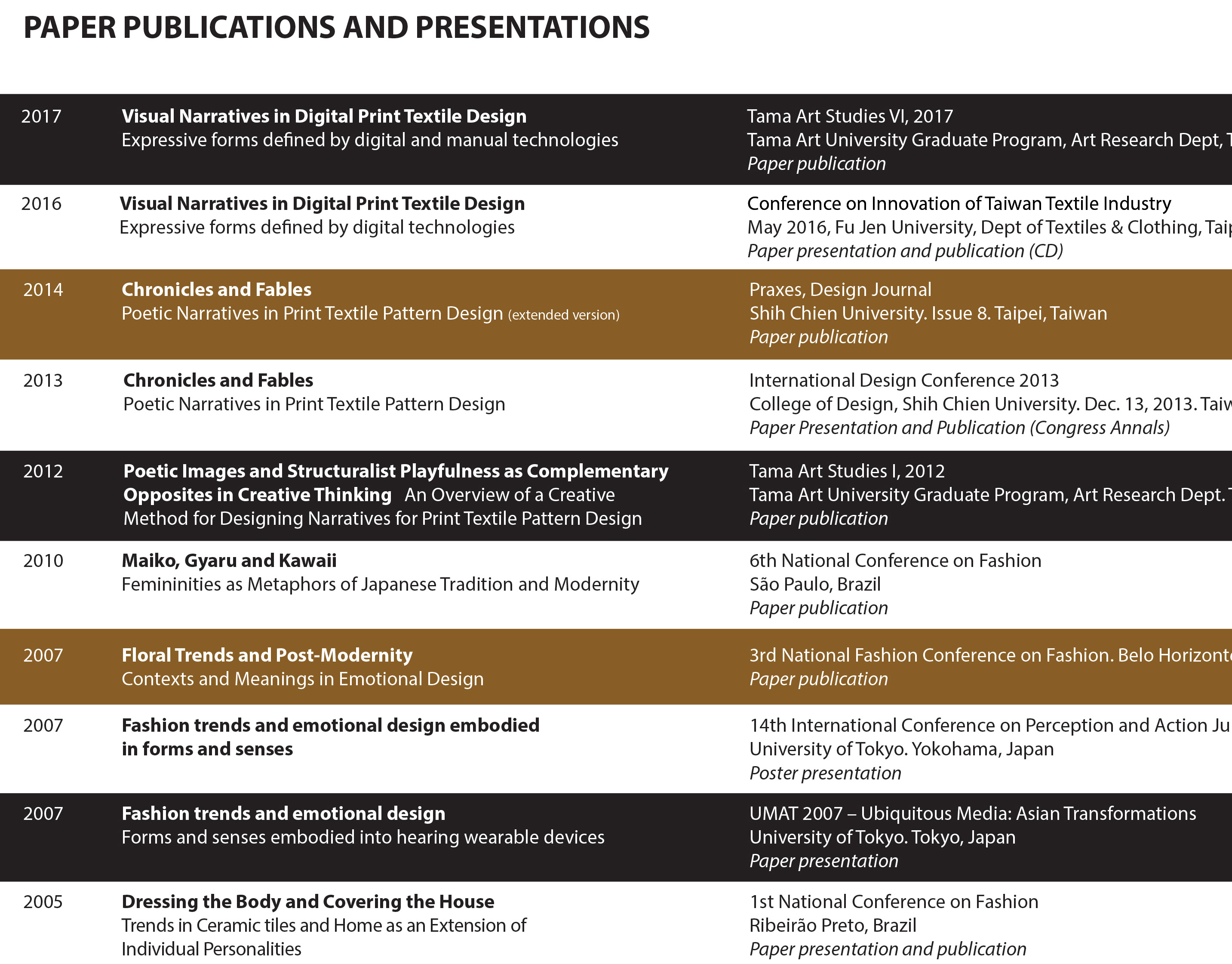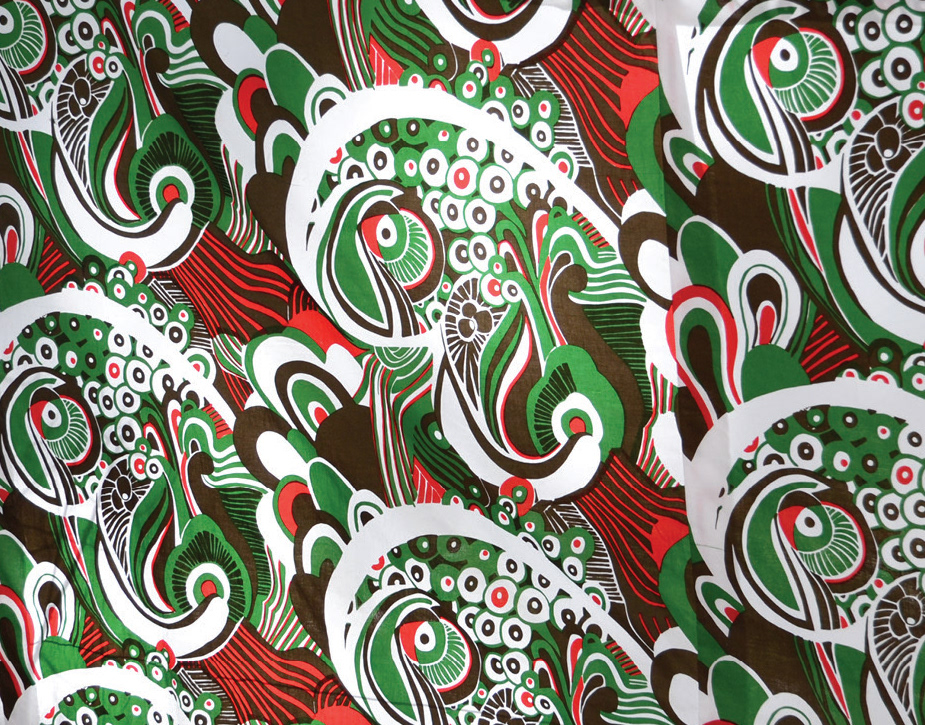At Anhembi Morumbi University, I developed a research on the application of fashion theory (trend discourses, lifestyles, post-modernist concepts) to analyze the trend discourses used by the ceramic tiles' industry, focusing on Italian and Spanish markets in contrast to the Brazilian market.
This monograph investigates the relations between Ceramic Tiles Design and Fashion Design, in the sense that both are skins used to cover different social and cultural spaces: our house and our bodies. There, I acknowledge, during my personal experience as a ceramic tiles designer, that our lifestyles and styles of living are affected by the surfaces (images, textures, colours, compositions, and materials) surrounding us. Such surfaces elicit emotional responses, by invoking our memories and the images of ourselves projected in the peoples, objects and spaces around us.
Abstract
The present work analyses the relation between dressing the body and covering the home, linking the following concepts: body/clothing and house/ceramic tiles. As a design product, ceramic tiles are seen as a value aggregator to an interior environment, playing a role in reflecting one’s personality. So, it will be studied as influenced by design, interior and fashion tendencies, and also by culture and social behavior. Fashion tendencies are understood as influencing social behavior with its values, like fast consumption, planned obsolescence, and search for the news.
This work starts from the principle that Tendencies, seen as plastically materialized social behavior, influence aesthetics’ configuration in fields like home interior, product design and fashion, contributing for their mutual pollination, while renewing the customer’s perception. In such a case, this triadic relation will be analyzed focusing ceramic tiles as the main purpose in studying tendencies and the relation between one’s personality and post-modern society.
1. Fashion, individual and society
Fashion trends reflect society in several domains, like the behavior, the speeches of thought, and social, economic, and productive structures, among others. Since the 1950’s it has been reflecting a consumer-oriented society, emphasizing the individuality, thus giving birth to Design and Fashion’s primacy over Art.
Consumer society’s post-modern values (Lipovetsky, 1989), spread through mass communication channels, tend to standardize the discourses of thought, giving them a superficial dimension. Such a society based on goods consumption tends to mould narcissist, hedonist personalities, guided by the constant search for the new, motivated by fashion changes. The desire of self-affirmation generates individualism (to be and to appear) (Embacher, 1999) which gains power with the standardization of consumption objects. In such a way, customization, personalization, and the desire to choose what fits best with individual personalities, are constantly looked after. On the other side, post-modernist’s loss of values (Santos, 1986) also generates the loss of references and meaning of life, leading to the search for references in the past in order to give new meanings to the discourses of thought, finally generating the contemporary’s eclecticism of styles.
2. Triad House-Object-Cloth
Design-related industries create methodologies to try to anticipate trends and consumer’s desires, because creating aesthetically pleasurable products is a marketing strategy related to the cult of the body. In a society motivated by mass consumption, objects become an extension of individual’s personality (Caldas, 2004). For this reason, industrial sectors are mutually influenced, because there is a “spirit of the time”, a certain way of living and doing that is plastically materialized in interior design, product design, and fashion design (Flugel, 1966; Caldas, 2004).
3. Home reflecting personality
The home is a dynamic space, filled with objects and life, and stage of human happenings. Its inhabitants are psychological subjects, carriers of reason and emotions, interacting with the physical media, thus eliciting responses to the environment (Okamoto, 2002). The several perceived senses allow individuals to be aware from themselves and from the surrounding world, in the process of feeling, desiring and thinking. Pleasure and the quest for comfort and well-being are the connective pattern between individuals and their environment. Thus, the environmental space must have its objective elements (light, illumination, temperature, etc) adapted to the subjective necessities of its inhabitants, in order to guarantee harmony in the environmental interaction.
Human beings are social beings who build their world’s representation according to the culture they live in. Their values, myths, symbols and beliefs are a result of their thought, through which they build their physical and symbolic universes. Basing his arguments in Hegel, Embacher (1999) states that the human being is a be-coming individual in search for his/her autonomy through the self-knowledge, seeking to develop and become a being-made-by-himself. Contemporary western societies allow individuals to be free to choose to live their own lifestyle, in the context of their social rules. In this sense, their lifestyles are a distillation of the spirit of the time adapted to their personality.
Architecture, like fashion and dress, is a medium of aesthetic communication and creation of meanings, through the articulation of its diverse visual elements (Colin, 2000). Robert Vischer’s theory of Einfuhlung (Colin, 2000) states that the aesthetic object carries and conveys the emotions of its creator; in the same sense, the interior environmental arrangement and decoration reflect its inhabitant’s personality, their familiar configuration and the spatiality of their way of living. Because individuals are in constant evolution, in search for its autonomy of thinking, home reflects their changing personality, continuously being readapted.
4. Fashion and the ceramic tiles’ plasticity
Spain and Italy are the world’s leading countries in the ceramic tiles industry, guiding trends in technological innovation and in products, causing the industry to work by the process of fashion diffusion known as Trickle-Down, in which tendencies are imposed by cultural and technological elites. The ceramic industry works inside the logic of fashion, influenced by endogenous trends (stones, marbles, glazing effects) and also by cross-pollinations from other industries (the triad interior design-product design-fashion design) (Caldas, 2004). The ceramic tiles industry has the paradox of constantly release new products, which reflect contemporary trends; however, it generates products with long-term life cycles. Thus, producers’ strategies are led by lines of products based in concepts which associate ceramic tiles to symbolic referents (wine colors, tree’s textures, park’s stones) or, more recently, to the consumer’s lifestyles, in the context of their home. Ceramic tiles become the cloth of the home, covering the interior environment and reflecting contemporary lifestyle’s discourses: young, urban, metropolitan, and globalized.
Ceramic tiles design is a specialization of Surface Design (Sudsilowsky, 2006), a field of study located between Product and Graphic Design, which develops graphic designs, textures and relieves for the industrial production of ceramic pavement and wall covering. Ceramic tiles design aims at the post-modern concept of simulacrum, the imitation of the reality (stones, marbles); nevertheless its versatility allows the creation of products containing any kind of superficial decoration. Besides the diversity of marbles, granites and stones, ceramic tiles display cemented graphics, wood, textiles, fibers and varied textures.
Ceramic tiles, because of its long-term permanency in a house, can be compared, for example, to the interventions made on the human skin, like tattoos, scarifications and piercings. However, if fashion design, for its transitory characteristic on the body, allows people to freely wear colors, shapes and contrasts, ceramic tiles design tends to be aesthetically neutral in terms of patterns, because it is grounded on modular pieces, composing graphic patterns.
Ceramic tiles’ fashion component is manifested on the choice of contemporary graphic designs and patterns, following tendencies from the fashion and, mainly, ceramic tiles’ industries. If fashion trends are divided in tops, bottoms and accessories, the ceramic tiles’ market is also composed of neutral pavements and coverings, and special pieces to complement and create points of interest in interior decoration. Following this concept, ceramic tiles’ complements, like listelli, tozzetti and other special pieces, even more tend to follow fashion tendencies, displaying motifs like floras, textiles, leather, and geometry, among others. On the other hand, pavements and coverings shall not follow seasonal trends because of its long-term use, in this case, being represented by concepts of lines of products.
If fashion parades use models to present their new collections, ceramic tiles producers eventually display new products associate to mannequins, to emphasize the relation between body and the idea of covering. Haute Couture and prêt-a-porter are the two market niches which divide the fashion industry: luxury goods for a few and casual wear for all. Recently (2005) in Brazil, it is being noticeable that some ceramic tiles producers established their own retail shops (concept stores), offering personalized staff and orientation of architects, similar to luxury fashion brands.
Technological innovations lead to new interpretations and results, and fashion tendencies lead to new graphic and conceptual results in terms of lifestyles. So, value is added by the design and ceramic effects, causing the ceramic tendency to arise from fashion trends, social behavior, culture, and technology.
5. Dressing the body and covering the home
According to the Greimasian semiotics, the body is the subject’s material support and discourse (Castilho, 2004); also the home can be seen as a significant structure, analogous to the body, and ceramic tiles can be seen as a cloth or second skin to cover floors and walls. But, according, respectively, to Castilho (2004), Barnard (2003) and Colin (2000), body, cloth and home can be seen as meaning carrier supports that also have intrinsic meanings. Then, ceramic tiles are value-objects, or sign-objects (Baudrillard, 1981) that, in contact to covering and pavement mural supports, through its aesthetic features, generate sensations and complement the environmental composition. Through the act of combining varied aesthetic elements to this value-object, the environment acquires new meanings, in a process similar to the body in contact to the cloth and accessories.
Ceramic tiles, in the context of a home, is a combination of content (symbolic meaning), movement (pagination, modularity, design, color, effects) and expression (perception) which, plastically, are valorized and limited in its different parts according to each culture. It is also possible to say that in the relation between the dressed body and the covered home, the home can be a support to enunciate narrative programs according to the intended function (seducing, receiving friends). But it’s important to notice that the dynamism of changes in a home is different from that of the body-cloth relation because if clothes allows the body to change its appearance and discourse according to the context, it doesn’t happens with the ceramic tiles, because it is permanently attached to the home.
The dressed body, in the context of a ceramic tiles’ covered home, is an image which merges the subject’s modes of being and appearing, materialized into several supports from the triad (interior design, fashion design, object design), thus generating discourses in different levels of signification. Cloth, for instance, when superposed into the body, must be analyzed as an extension of the subject’s personality, due to its dynamic, public character, because it is most frequently subject to fashion’s seasonal prescriptions; on the other hand, home, when covered with ceramic tiles, has a stronger character of privacy and, in terms of fashion, a relatively weaker dynamism, even though equally revealing its inhabitant’s personality, culture and lifestyle. This way, home and ceramic tiles are both a reflex of the society’s ethic and aesthetic conceptions, in terms of behavior, customs, beauty, and culture.
Relatively to the dressed individual inhabiting the ceramic tiles’ covered home, the cloth’s plastic and graphic elements reflected in the home, or vice-versa, are articulate in a relation mediated by the spirit of the time and by the individual’s personality, as for the choice of the decorative elements. Post-modern values are reflected in these choices as well, like the eclecticism of styles, the cannibalism of the past through the revival of styles, the loss of meaning of individual values compared to pre-war periods, the object’s loss of materialization due to the primacy of concepts and signs in consumption and in discourses of meaning, the planned obsolescence, the conspicuous consumption, the quest for pleasure, well-being, comfort and functionality in relation to the home. There’s an influence from the individual’s lifestyle in the choice of elements which are gathered to different supports of communication, ending up reflecting his personality.
According to Baudrillard (1981), in order to be post-modern, an object must be seen as symbol (meaning, concept, and semantics), tool (utility), and product (price). Ceramic tiles, when adopting the concept of “dressing” the home, through politics of lines of products, becomes a post-modern product, an object-sign, because it is not a product anymore, but a sign, a metaphor of lifestyles. In this context, home and ceramic tiles can be seen as a result of fashion discourses, like:
+ Bricolage (Levi-Strauss, 1966; Derrida, 1978): eclecticism, mix of styles generating new meanings;
+ Pastiche (Jameson, 1984): re-interpretations and imitation of styles;
+ Undecidibility (Derrida, 1978): not fixed meanings. Meanings change depending on discourses, in relations of similarity and difference; and
+ Allegory (Sawchuk, 1988): Derrida’s concept of intertextual relations, ie, ambiguity, multiplicity of meanings among many discourses and texts, subject to temporal interpretations. In this sense, ceramic tiles can be seen as a building material or a decorative object.
Conclusion
This monograph intended to demonstrate that the ceramic tiles sector is being marketed as a complement of style, replacing the previous perception of a building material. In this sense, its dynamics is being regulated by the Fashion System, by the principles of constant renovation, fast fashion, seasonal releasing, and superficiality of discourses which reflects contemporary society.
It was shown that combinations of meaningful plastic elements disclose the subject’s style and that the creation of discourses relates possible choices (materials, colors, forms, etc) with possible combinations among them.
The way personal preferences are articulate result in the construction of personal and identity relations with the individual’s body and home, and with society, world vision, status and cultural values (Castilho, 2004).
Bibliography
BARNARD, Malcolm (2003). Fashion and Communication. Rio de Janeiro: Rocco.
BAUDRILLARD, Jean (1981). For a critique of the political economy of the sign. St.Louis, Mo.: Telos Press Ltd.
CALDAS, Dario (2004). The observatory of signs: Theory and praxis of trends research. Rio de Janeiro: Senac.
CASTILHO, Kathia (2004). Fashion and language. Sao Paulo: Anhembi Morumbi.
COLIN, Silvio (2000). An introduction to architecture. Rio de Janeiro: UAPE.
DERRIDA, J (1978). Spurs/Eperons. Chicago, Ill. University of Chicago Press.
EMBACHER, Airton (1999). Fashion and identity: the construction of a personal style. Sao Paulo: Anhembi Morumbi.
FLUGEL, J.C. (1966). The psychology of clothes. Sao Paulo: Mestre Jou.
JAMESON, Frederic (1984). Postmodernism and the cultural logic of late capitalism. New Left Review, 146 (Autumn): 53-92.
LEVI-STRAUSS, C (1966). The savage mind. London: Weidenfeld and Nicholson.
LIPOVETSKY, Gilles (1989). L’empire de l’ephemere: la mode et son destin dans les societes contemporains. Sao Paulo: Companhia das Letras.
OKAMOTO, Jun (2002). Environmental perception and behavior: An holistic vision of environmental perception applied in architecture and communication. Sao Paulo: Mackenzie.
SANTOS, Jair F. (1986). What is “Post-Modern”? Sao Paulo: Brasiliense.
SAWCHUK, K (1988). “A tale of inscription/fashion statements” in Kroker, A. and M. (org.) Body Invaders: Sexuality and the Post-Modern Condition. London: Macmillan.
SUDSILOWSKY, S (2006). Surface Design: a brand new field or a hybrid? 7th Congress on Research and Development in Design/Parana.
TRAMONTANO, Marcelo (1993). New ways of living, new living spaces. EESC-USP, Department of Architecture and Urbanism. Sao Carlos, 3rd.reimpression (2002). 08019.



